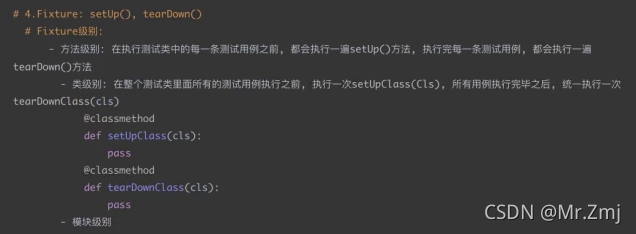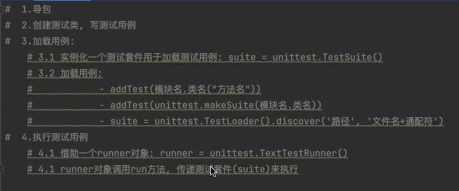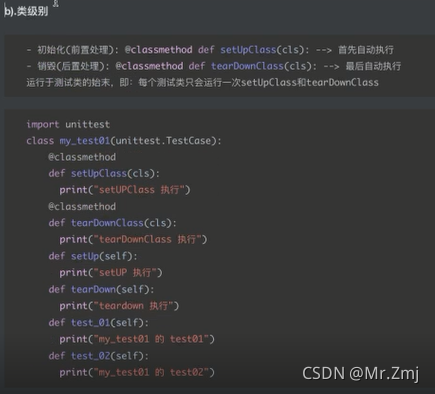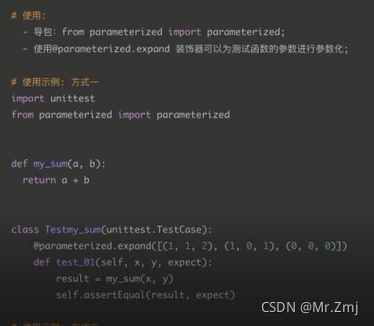1.unittest


例1:
mymytest.py 和main.py都在case文件夹中
在mymytest.py文件中
import unittest
def two_he(a,b):
print(a+b)
return a+b
class BdTestClass(unittest.TestCase):
def test_1(self):
two_he(1,2)
在main.py文件中
import unittest
from case import mymytest
suite=unittest.TestSuite()
suite.addTest(mymytest.BdTestClass("test_1"))
runner=unittest.TextTestRunner()
runner.run(suite)
例2:
mymytest.py 和main.py都在case文件夹中
在mymytest.py文件中
import unittest
# 待测函数
def two_he(a,b):
print(a+b)
return a+b
# 测试类:方法-->测试用例
# 注意事项:测试类,必须继承unittest.TestCase
# 测试用例:就是方法,方法必须以test开头
class BdTestClass(unittest.TestCase):
def test_1(self):
two_he(1,2)
def test_2(self):
two_he('abc',5)
在main.py文件中
import unittest
from case import mymytest
suite=unittest.TestSuite()
suite.addTest(mymytest.BdTestClass("test_1"))
suite.addTest(mymytest.BdTestClass("test_2"))
runner=unittest.TextTestRunner()
runner.run(suite)
例3:
mymytest.py 和main.py都在case文件夹中
在mymytest.py文件中
import unittest
def two_he(a,b):
print(a+b)
return a+b
class BdTestClass(unittest.TestCase):
def test_1(self):
two_he(1,2)
def test_2(self):
two_he('abc',5)
在main.py文件中
import unittest
from case import mymytest
suite=unittest.TestSuite()
suite.addTest(unittest.makeSuite(mymytest.BdTestClass))
runner=unittest.TextTestRunner()
runner.run(suite)
和例2效果一样
例4:
测试一个文件夹下的所有要测的文件
mymytest.py 和yotest.py都在case文件夹中
main.py文件在case文件夹之外(和cace同级)
在mymytest.py文件中
import unittest
def two_he(a,b):
print(a+b)
return a+b
class BdTestClass(unittest.TestCase):
def test_1(self):
two_he(1,2)
def test_2(self):
two_he('abc',5)
在yotest.py文件中
import unittest
def th_he(a,b,c):
print(a+b)
return a+b
class ShTestClass(unittest.TestCase):
def test_1(self):
th_he(1,2,3)
def test_2(self):
th_he('abc',5,6)
在main.py文件中
import unittest
suite=unittest.TestLoader().discover('../case','*test.py')
runner=unittest.TextTestRunner()
runner.run(suite)

yotest.py和mymytest.py文件都测试
2.Fixture

 ?
?
例
mymytest.py 在case文件夹中
在mymytest.py中
import unittest
def two_he(a,b):
return a+b
class BdTestClass(unittest.TestCase):
def setUp(self) -> None:
print('setup开始执行')
def tearDown(self) -> None:
print('teardown开始执行')
def test_1(self):
two_he(1,2)
print('test1')
def test_2(self):
two_he(9,5)
print('test2')
?main.py文件与case文件夹同级
在main.py 中
import unittest from case import mymytest suite=unittest.TestSuite() suite.addTest(unittest.makeSuite(mymytest.BdTestClass)) runner=unittest.TextTestRunner() runner.run(suite)

?例
mymytest.py 在case文件夹中
在mymytest.py中
import unittest
def two_he(a,b):
return a+b
class BdTestClass(unittest.TestCase):
@classmethod
def setUpClass(cls) -> None:
print('setupclass开始执行')
@classmethod
def tearDownClass(cls) -> None:
print('teardownclass开始执行')
def test_1(self):
two_he(1,2)
print('test1')
def test_2(self):
two_he(9,5)
print('test2')
?main.py文件与case文件夹同级
在main.py 中
import unittest from case import mymytest suite=unittest.TestSuite() suite.addTest(unittest.makeSuite(mymytest.BdTestClass)) runner=unittest.TextTestRunner() runner.run(suite)

 ?
?
3.断言,参数化与跳过操作?

 ?
?
?例
mymytest.py 在case文件夹中
在mymytest.py中
import unittest
def two_he(a,b):
return a+b
class BdTestClass(unittest.TestCase):
def test_1(self):
ret=two_he(1,2)
self.assertEqual(3,ret,msg='不等于3')
def test_2(self):
ret=two_he(9,5)
self.assertEqual(12,ret,msg='不等于12')
?main.py文件与case文件夹同级
在main.py 中
import unittest from case import mymytest suite=unittest.TestSuite() suite.addTest(unittest.makeSuite(mymytest.BdTestClass)) runner=unittest.TextTestRunner() runner.run(suite)
参数化

安装:pip install parameterized

 ?
?
例
mymytest.py 在case文件夹中
在mymytest.py中
from parameterized import parameterized import unittest def two_he(a,b): return a+b class BdTestClass(unittest.TestCase): @parameterized.expand([(1,2,3),(2,2,3),(3,2,5),(0,2,2)]) def test_1(self,x,y,exp): ret=two_he(x,y) self.assertEqual(exp,ret,msg='不相等')
?main.py文件与case文件夹同级
在main.py 中
import unittest from case import mymytest suite=unittest.TestSuite() suite.addTest(unittest.makeSuite(mymytest.BdTestClass)) runner=unittest.TextTestRunner() runner.run(suite)
例
建立data.json文件,与case文件夹同级,
在data.json中
[
{"x": 1,"y": 2,"exp": 3},
{"x": 1,"y": 3,"exp": 4},
{"x": 1,"y": 2,"exp": 5},
{"x": 2,"y": 2,"exp": 4}
]
mymytest.py 在case文件夹中
在mymytest.py中
import json from parameterized import parameterized import unittest def two_he(a,b): return a+b def build_data(): with open('./data.json','r',encoding='utf-8')as f: # 注意/data.json前面的点,有的地方是两个点 content=f.read() d=[(i["x"],i["y"],i["exp"]) for i in json.loads(content)] return d class BdTestClass(unittest.TestCase): @parameterized.expand(build_data) # build_data() 也可以 def test_1(self,x,y,exp): ret=two_he(x,y) self.assertEqual(exp,ret,msg='不相等')
?
?main.py文件与case文件夹同级
在main.py 中
import unittest from case import mymytest suite=unittest.TestSuite() suite.addTest(unittest.makeSuite(mymytest.BdTestClass)) runner=unittest.TextTestRunner() runner.run(suite)
跳过用例

?例
建立data.json文件,与case文件夹同级,
在data.json中
[
{"x": 1,"y": 2,"exp": 3},
{"x": 1,"y": 3,"exp": 4},
{"x": 1,"y": 2,"exp": 5},
{"x": 2,"y": 2,"exp": 4}
]
mymytest.py 在case文件夹中
在mymytest.py中
import json
from parameterized import parameterized
import unittest
def two_he(a,b):
return a+b
def build_data():
with open('./data.json','r',encoding='utf-8')as f:
content=f.read()
d=[(i["x"],i["y"],i["exp"]) for i in json.loads(content)]
return d
class BdTestClass(unittest.TestCase):
@parameterized.expand(build_data())
def test_1(self,x,y,exp):
ret=two_he(x,y)
self.assertEqual(exp,ret,msg='不相等')
@unittest.skip('不执行')
def test_2(self):
ret=two_he(1,9)
self.assertEqual(12,ret,msg='不相等')
?main.py文件与case文件夹同级
在main.py 中
import unittest from case import mymytest suite=unittest.TestSuite() suite.addTest(unittest.makeSuite(mymytest.BdTestClass)) runner=unittest.TextTestRunner() runner.run(suite)
例
建立data.json文件,与case文件夹同级,
在data.json中
[
{"x": 1,"y": 2,"exp": 3},
{"x": 1,"y": 3,"exp": 4},
{"x": 1,"y": 2,"exp": 5},
{"x": 2,"y": 2,"exp": 4}
]
mymytest.py 在case文件夹中
在mymytest.py中
import json from parameterized import parameterized import unittest v=1.0 def two_he(a,b): return a+b def build_data(): with open('./data.json','r',encoding='utf-8')as f: content=f.read() d=[(i["x"],i["y"],i["exp"]) for i in json.loads(content)] return d class BdTestClass(unittest.TestCase): @parameterized.expand(build_data()) def test_1(self,x,y,exp): ret=two_he(x,y) self.assertEqual(exp,ret,msg='不相等') @unittest.skipIf(v==1.0,'不执行') # v==1.0会跳过,等于其他的就不会跳过 def test_2(self): ret=two_he(1,9) self.assertEqual(12,ret,msg='不相等')
main.py文件与case文件夹同级
在main.py 中
import unittest from case import mymytest suite=unittest.TestSuite() suite.addTest(unittest.makeSuite(mymytest.BdTestClass)) runner=unittest.TextTestRunner() runner.run(suite)
4.生成HTML测试报告

?建一个py文件,与case文件夹同级,名字是HTMLTestRunner.py,把下面的代码粘贴进去
"""
A TestRunner for use with the Python unit testing framework. It
generates a HTML report to show the result at a glance.
The simplest way to use this is to invoke its main method. E.g.
import unittest
import HTMLTestRunner
... define your tests ...
if __name__ == '__main__':
HTMLTestRunner.main()
For more customization options, instantiates a HTMLTestRunner object.
HTMLTestRunner is a counterpart to unittest's TextTestRunner. E.g.
# output to a file
fp = file('my_report.html', 'wb')
runner = HTMLTestRunner.HTMLTestRunner(
stream=fp,
title='My unit test',
description='This demonstrates the report output by HTMLTestRunner.'
)
# Use an external stylesheet.
# See the Template_mixin class for more customizable options
runner.STYLESHEET_TMPL = '<link rel="stylesheet" href="my_stylesheet.css" type="text/css">'
# run the test
runner.run(my_test_suite)
------------------------------------------------------------------------
Copyright (c) 2004-2007, Wai Yip Tung
All rights reserved.
Redistribution and use in source and binary forms, with or without
modification, are permitted provided that the following conditions are
met:
* Redistributions of source code must retain the above copyright notice,
this list of conditions and the following disclaimer.
* Redistributions in binary form must reproduce the above copyright
notice, this list of conditions and the following disclaimer in the
documentation and/or other materials provided with the distribution.
* Neither the name Wai Yip Tung nor the names of its contributors may be
used to endorse or promote products derived from this software without
specific prior written permission.
THIS SOFTWARE IS PROVIDED BY THE COPYRIGHT HOLDERS AND CONTRIBUTORS "AS
IS" AND ANY EXPRESS OR IMPLIED WARRANTIES, INCLUDING, BUT NOT LIMITED
TO, THE IMPLIED WARRANTIES OF MERCHANTABILITY AND FITNESS FOR A
PARTICULAR PURPOSE ARE DISCLAIMED. IN NO EVENT SHALL THE COPYRIGHT OWNER
OR CONTRIBUTORS BE LIABLE FOR ANY DIRECT, INDIRECT, INCIDENTAL, SPECIAL,
EXEMPLARY, OR CONSEQUENTIAL DAMAGES (INCLUDING, BUT NOT LIMITED TO,
PROCUREMENT OF SUBSTITUTE GOODS OR SERVICES; LOSS OF USE, DATA, OR
PROFITS; OR BUSINESS INTERRUPTION) HOWEVER CAUSED AND ON ANY THEORY OF
LIABILITY, WHETHER IN CONTRACT, STRICT LIABILITY, OR TORT (INCLUDING
NEGLIGENCE OR OTHERWISE) ARISING IN ANY WAY OUT OF THE USE OF THIS
SOFTWARE, EVEN IF ADVISED OF THE POSSIBILITY OF SUCH DAMAGE.
"""
# URL: http://tungwaiyip.info/software/HTMLTestRunner.html
__author__ = "Wai Yip Tung"
__version__ = "0.8.2"
"""
Change History
Version 0.8.2
* Show output inline instead of popup window (Viorel Lupu).
Version in 0.8.1
* Validated XHTML (Wolfgang Borgert).
* Added description of test classes and test cases.
Version in 0.8.0
* Define Template_mixin class for customization.
* Workaround a IE 6 bug that it does not treat <script> block as CDATA.
Version in 0.7.1
* Back port to Python 2.3 (Frank Horowitz).
* Fix missing scroll bars in detail log (Podi).
"""
# TODO: color stderr
# TODO: simplify javascript using ,ore than 1 class in the class attribute?
import datetime
import io
import sys
import time
import unittest
from xml.sax import saxutils
# ------------------------------------------------------------------------
# The redirectors below are used to capture output during testing. Output
# sent to sys.stdout and sys.stderr are automatically captured. However
# in some cases sys.stdout is already cached before HTMLTestRunner is
# invoked (e.g. calling logging.basicConfig). In order to capture those
# output, use the redirectors for the cached stream.
#
# e.g.
# >>> logging.basicConfig(stream=HTMLTestRunner.stdout_redirector)
# >>>
class OutputRedirector(object):
""" Wrapper to redirect stdout or stderr """
def __init__(self, fp):
self.fp = fp
def write(self, s):
self.fp.write(s)
def writelines(self, lines):
self.fp.writelines(lines)
def flush(self):
self.fp.flush()
stdout_redirector = OutputRedirector(sys.stdout)
stderr_redirector = OutputRedirector(sys.stderr)
# ----------------------------------------------------------------------
# Template
class Template_mixin(object):
"""
Define a HTML template for report customerization and generation.
Overall structure of an HTML report
HTML
+------------------------+
|<html> |
| <head> |
| |
| STYLESHEET |
| +----------------+ |
| | | |
| +----------------+ |
| |
| </head> |
| |
| <body> |
| |
| HEADING |
| +----------------+ |
| | | |
| +----------------+ |
| |
| REPORT |
| +----------------+ |
| | | |
| +----------------+ |
| |
| ENDING |
| +----------------+ |
| | | |
| +----------------+ |
| |
| </body> |
|</html> |
+------------------------+
"""
STATUS = {
0: 'pass',
1: 'fail',
2: 'error',
}
DEFAULT_TITLE = 'Unit Test Report'
DEFAULT_DESCRIPTION = ''
# ------------------------------------------------------------------------
# HTML Template
HTML_TMPL = r"""<?xml version="1.0" encoding="UTF-8"?>
<!DOCTYPE html PUBLIC "-//W3C//DTD XHTML 1.0 Strict//EN" "http://www.w3.org/TR/xhtml1/DTD/xhtml1-strict.dtd">
<html xmlns="http://www.w3.org/1999/xhtml">
<head>
<title>%(title)s</title>
<meta name="generator" content="%(generator)s"/>
<meta http-equiv="Content-Type" content="text/html; charset=UTF-8"/>
%(stylesheet)s
</head>
<body>
<script language="javascript" type="text/javascript"><!--
output_list = Array();
/* level - 0:Summary; 1:Failed; 2:All */
function showCase(level) {
trs = document.getElementsByTagName("tr");
for (var i = 0; i < trs.length; i++) {
tr = trs[i];
id = tr.id;
if (id.substr(0,2) == 'ft') {
if (level < 1) {
tr.className = 'hiddenRow';
}
else {
tr.className = '';
}
}
if (id.substr(0,2) == 'pt') {
if (level > 1) {
tr.className = '';
}
else {
tr.className = 'hiddenRow';
}
}
}
}
function showClassDetail(cid, count) {
var id_list = Array(count);
var toHide = 1;
for (var i = 0; i < count; i++) {
tid0 = 't' + cid.substr(1) + '.' + (i+1);
tid = 'f' + tid0;
tr = document.getElementById(tid);
if (!tr) {
tid = 'p' + tid0;
tr = document.getElementById(tid);
}
id_list[i] = tid;
if (tr.className) {
toHide = 0;
}
}
for (var i = 0; i < count; i++) {
tid = id_list[i];
if (toHide) {
document.getElementById('div_'+tid).style.display = 'none'
document.getElementById(tid).className = 'hiddenRow';
}
else {
document.getElementById(tid).className = '';
}
}
}
function showTestDetail(div_id){
var details_div = document.getElementById(div_id)
var displayState = details_div.style.display
// alert(displayState)
if (displayState != 'block' ) {
displayState = 'block'
details_div.style.display = 'block'
}
else {
details_div.style.display = 'none'
}
}
function html_escape(s) {
s = s.replace(/&/g,'&');
s = s.replace(/</g,'<');
s = s.replace(/>/g,'>');
return s;
}
/* obsoleted by detail in <div>
function showOutput(id, name) {
var w = window.open("", //url
name,
"resizable,scrollbars,status,width=800,height=450");
d = w.document;
d.write("<pre>");
d.write(html_escape(output_list[id]));
d.write("\n");
d.write("<a href='javascript:window.close()'>close</a>\n");
d.write("</pre>\n");
d.close();
}
*/
--></script>
%(heading)s
%(report)s
%(ending)s
</body>
</html>
"""
# variables: (title, generator, stylesheet, heading, report, ending)
# ------------------------------------------------------------------------
# Stylesheet
#
# alternatively use a <link> for external style sheet, e.g.
# <link rel="stylesheet" href="$url" type="text/css">
STYLESHEET_TMPL = """
<style type="text/css" media="screen">
body { font-family: verdana, arial, helvetica, sans-serif; font-size: 80%; }
table { font-size: 100%; }
pre { }
/* -- heading ---------------------------------------------------------------------- */
h1 {
font-size: 16pt;
color: gray;
}
.heading {
margin-top: 0ex;
margin-bottom: 1ex;
}
.heading .attribute {
margin-top: 1ex;
margin-bottom: 0;
}
.heading .description {
margin-top: 4ex;
margin-bottom: 6ex;
}
/* -- css div popup ------------------------------------------------------------------------ */
a.popup_link {
}
a.popup_link:hover {
color: red;
}
.popup_window {
display: none;
position: relative;
left: 0px;
top: 0px;
/*border: solid #627173 1px; */
padding: 10px;
background-color: #E6E6D6;
font-family: "Lucida Console", "Courier New", Courier, monospace;
text-align: left;
font-size: 8pt;
width: 500px;
}
}
/* -- report ------------------------------------------------------------------------ */
#show_detail_line {
margin-top: 3ex;
margin-bottom: 1ex;
}
#result_table {
width: 80%;
border-collapse: collapse;
border: 1px solid #777;
}
#header_row {
font-weight: bold;
color: white;
background-color: #777;
}
#result_table td {
border: 1px solid #777;
padding: 2px;
}
#total_row { font-weight: bold; }
.passClass { background-color: #6c6; }
.failClass { background-color: #c60; }
.errorClass { background-color: #c00; }
.passCase { color: #6c6; }
.failCase { color: #c60; font-weight: bold; }
.errorCase { color: #c00; font-weight: bold; }
.hiddenRow { display: none; }
.testcase { margin-left: 2em; }
/* -- ending ---------------------------------------------------------------------- */
#ending {
}
</style>
"""
# ------------------------------------------------------------------------
# Heading
#
HEADING_TMPL = """<div class='heading'>
<h1>%(title)s</h1>
%(parameters)s
<p class='description'>%(description)s</p>
</div>
""" # variables: (title, parameters, description)
HEADING_ATTRIBUTE_TMPL = """<p class='attribute'><strong>%(name)s:</strong> %(value)s</p>
""" # variables: (name, value)
# ------------------------------------------------------------------------
# Report
#
REPORT_TMPL = """
<p id='show_detail_line'>Show
<a href='javascript:showCase(0)'>Summary</a>
<a href='javascript:showCase(1)'>Failed</a>
<a href='javascript:showCase(2)'>All</a>
</p>
<table id='result_table'>
<colgroup>
<col align='left' />
<col align='right' />
<col align='right' />
<col align='right' />
<col align='right' />
<col align='right' />
</colgroup>
<tr id='header_row'>
<td>Test Group/Test case</td>
<td>Count</td>
<td>Pass</td>
<td>Fail</td>
<td>Error</td>
<td>View</td>
</tr>
%(test_list)s
<tr id='total_row'>
<td>Total</td>
<td>%(count)s</td>
<td>%(Pass)s</td>
<td>%(fail)s</td>
<td>%(error)s</td>
<td> </td>
</tr>
</table>
""" # variables: (test_list, count, Pass, fail, error)
REPORT_CLASS_TMPL = r"""
<tr class='%(style)s'>
<td>%(desc)s</td>
<td>%(count)s</td>
<td>%(Pass)s</td>
<td>%(fail)s</td>
<td>%(error)s</td>
<td><a href="javascript:showClassDetail('%(cid)s',%(count)s)">Detail</a></td>
</tr>
""" # variables: (style, desc, count, Pass, fail, error, cid)
REPORT_TEST_WITH_OUTPUT_TMPL = r"""
<tr id='%(tid)s' class='%(Class)s'>
<td class='%(style)s'><div class='testcase'>%(desc)s</div></td>
<td colspan='5' align='center'>
<!--css div popup start-->
<a class="popup_link" onfocus='this.blur();' href="javascript:showTestDetail('div_%(tid)s')" >
%(status)s</a>
<div id='div_%(tid)s' class="popup_window">
<div style='text-align: right; color:red;cursor:pointer'>
<a onfocus='this.blur();' onclick="document.getElementById('div_%(tid)s').style.display = 'none' " >
[x]</a>
</div>
<pre>
%(script)s
</pre>
</div>
<!--css div popup end-->
</td>
</tr>
""" # variables: (tid, Class, style, desc, status)
REPORT_TEST_NO_OUTPUT_TMPL = r"""
<tr id='%(tid)s' class='%(Class)s'>
<td class='%(style)s'><div class='testcase'>%(desc)s</div></td>
<td colspan='5' align='center'>%(status)s</td>
</tr>
""" # variables: (tid, Class, style, desc, status)
REPORT_TEST_OUTPUT_TMPL = r"""
%(id)s: %(output)s
""" # variables: (id, output)
# ------------------------------------------------------------------------
# ENDING
#
ENDING_TMPL = """<div id='ending'> </div>"""
# -------------------- The end of the Template class -------------------
TestResult = unittest.TestResult
class _TestResult(TestResult):
# note: _TestResult is a pure representation of results.
# It lacks the output and reporting ability compares to unittest._TextTestResult.
def __init__(self, verbosity=1):
TestResult.__init__(self)
self.stdout0 = None
self.stderr0 = None
self.success_count = 0
self.failure_count = 0
self.error_count = 0
self.verbosity = verbosity
# result is a list of result in 4 tuple
# (
# result code (0: success; 1: fail; 2: error),
# TestCase object,
# Test output (byte string),
# stack trace,
# )
self.result = []
def startTest(self, test):
TestResult.startTest(self, test)
# just one buffer for both stdout and stderr
self.outputBuffer = io.StringIO()
stdout_redirector.fp = self.outputBuffer
stderr_redirector.fp = self.outputBuffer
self.stdout0 = sys.stdout
self.stderr0 = sys.stderr
sys.stdout = stdout_redirector
sys.stderr = stderr_redirector
def complete_output(self):
"""
Disconnect output redirection and return buffer.
Safe to call multiple times.
"""
if self.stdout0:
sys.stdout = self.stdout0
sys.stderr = self.stderr0
self.stdout0 = None
self.stderr0 = None
return self.outputBuffer.getvalue()
def stopTest(self, test):
# Usually one of addSuccess, addError or addFailure would have been called.
# But there are some path in unittest that would bypass this.
# We must disconnect stdout in stopTest(), which is guaranteed to be called.
self.complete_output()
def addSuccess(self, test):
self.success_count += 1
TestResult.addSuccess(self, test)
output = self.complete_output()
self.result.append((0, test, output, ''))
if self.verbosity > 1:
sys.stderr.write('ok ')
sys.stderr.write(str(test))
sys.stderr.write('\n')
else:
sys.stderr.write('.')
def addError(self, test, err):
self.error_count += 1
TestResult.addError(self, test, err)
_, _exc_str = self.errors[-1]
output = self.complete_output()
self.result.append((2, test, output, _exc_str))
if self.verbosity > 1:
sys.stderr.write('E ')
sys.stderr.write(str(test))
sys.stderr.write('\n')
else:
sys.stderr.write('E')
def addFailure(self, test, err):
self.failure_count += 1
TestResult.addFailure(self, test, err)
_, _exc_str = self.failures[-1]
output = self.complete_output()
self.result.append((1, test, output, _exc_str))
if self.verbosity > 1:
sys.stderr.write('F ')
sys.stderr.write(str(test))
sys.stderr.write('\n')
else:
sys.stderr.write('F')
class HTMLTestRunner(Template_mixin):
"""
"""
def __init__(self, stream=sys.stdout, verbosity=1, title=None, description=None):
self.stream = stream
self.verbosity = verbosity
if title is None:
self.title = self.DEFAULT_TITLE
else:
self.title = title
if description is None:
self.description = self.DEFAULT_DESCRIPTION
else:
self.description = description
self.startTime = datetime.datetime.now()
def run(self, test):
"Run the given test case or test suite."
result = _TestResult(self.verbosity)
test(result)
self.stopTime = datetime.datetime.now()
self.generateReport(test, result)
print(sys.stderr, '\nTimeElapsed: %s' % (self.stopTime-self.startTime))
return result
def sortResult(self, result_list):
# unittest does not seems to run in any particular order.
# Here at least we want to group them together by class.
rmap = {}
classes = []
for n,t,o,e in result_list:
cls = t.__class__
if not cls in rmap:
rmap[cls] = []
classes.append(cls)
rmap[cls].append((n,t,o,e))
r = [(cls, rmap[cls]) for cls in classes]
return r
def getReportAttributes(self, result):
"""
Return report attributes as a list of (name, value).
Override this to add custom attributes.
"""
startTime = str(self.startTime)[:19]
duration = str(self.stopTime - self.startTime)
status = []
if result.success_count: status.append('Pass %s' % result.success_count)
if result.failure_count: status.append('Failure %s' % result.failure_count)
if result.error_count: status.append('Error %s' % result.error_count )
if status:
status = ' '.join(status)
else:
status = 'none'
return [
('Start Time', startTime),
('Duration', duration),
('Status', status),
]
def generateReport(self, test, result):
report_attrs = self.getReportAttributes(result)
generator = 'HTMLTestRunner %s' % __version__
stylesheet = self._generate_stylesheet()
heading = self._generate_heading(report_attrs)
report = self._generate_report(result)
ending = self._generate_ending()
output = self.HTML_TMPL % dict(
title = saxutils.escape(self.title),
generator = generator,
stylesheet = stylesheet,
heading = heading,
report = report,
ending = ending,
)
self.stream.write(output.encode('utf8'))
def _generate_stylesheet(self):
return self.STYLESHEET_TMPL
def _generate_heading(self, report_attrs):
a_lines = []
for name, value in report_attrs:
line = self.HEADING_ATTRIBUTE_TMPL % dict(
name = saxutils.escape(name),
value = saxutils.escape(value),
)
a_lines.append(line)
heading = self.HEADING_TMPL % dict(
title = saxutils.escape(self.title),
parameters = ''.join(a_lines),
description = saxutils.escape(self.description),
)
return heading
def _generate_report(self, result):
rows = []
sortedResult = self.sortResult(result.result)
for cid, (cls, cls_results) in enumerate(sortedResult):
# subtotal for a class
np = nf = ne = 0
for n,t,o,e in cls_results:
if n == 0: np += 1
elif n == 1: nf += 1
else: ne += 1
# format class description
if cls.__module__ == "__main__":
name = cls.__name__
else:
name = "%s.%s" % (cls.__module__, cls.__name__)
doc = cls.__doc__ and cls.__doc__.split("\n")[0] or ""
desc = doc and '%s: %s' % (name, doc) or name
row = self.REPORT_CLASS_TMPL % dict(
style = ne > 0 and 'errorClass' or nf > 0 and 'failClass' or 'passClass',
desc = desc,
count = np+nf+ne,
Pass = np,
fail = nf,
error = ne,
cid = 'c%s' % (cid+1),
)
rows.append(row)
for tid, (n,t,o,e) in enumerate(cls_results):
self._generate_report_test(rows, cid, tid, n, t, o, e)
report = self.REPORT_TMPL % dict(
test_list = ''.join(rows),
count = str(result.success_count+result.failure_count+result.error_count),
Pass = str(result.success_count),
fail = str(result.failure_count),
error = str(result.error_count),
)
return report
def _generate_report_test(self, rows, cid, tid, n, t, o, e):
# e.g. 'pt1.1', 'ft1.1', etc
has_output = bool(o or e)
tid = (n == 0 and 'p' or 'f') + 't%s.%s' % (cid+1,tid+1)
name = t.id().split('.')[-1]
doc = t.shortDescription() or ""
desc = doc and ('%s: %s' % (name, doc)) or name
tmpl = has_output and self.REPORT_TEST_WITH_OUTPUT_TMPL or self.REPORT_TEST_NO_OUTPUT_TMPL
# o and e should be byte string because they are collected from stdout and stderr?
if isinstance(o,str):
# TODO: some problem with 'string_escape': it escape \n and mess up formating
# uo = unicode(o.encode('string_escape'))
uo = o
else:
uo = o
if isinstance(e,str):
# TODO: some problem with 'string_escape': it escape \n and mess up formating
# ue = unicode(e.encode('string_escape'))
ue = e
else:
ue = e
script = self.REPORT_TEST_OUTPUT_TMPL % dict(
id = tid,
output = saxutils.escape(uo+ue),
)
row = tmpl % dict(
tid = tid,
Class = (n == 0 and 'hiddenRow' or 'none'),
style = n == 2 and 'errorCase' or (n == 1 and 'failCase' or 'none'),
desc = desc,
script = script,
status = self.STATUS[n],
)
rows.append(row)
if not has_output:
return
def _generate_ending(self):
return self.ENDING_TMPL
##############################################################################
# Facilities for running tests from the command line
##############################################################################
# Note: Reuse unittest.TestProgram to launch test. In the future we may
# build our own launcher to support more specific command line
# parameters like test title, CSS, etc.
class TestProgram(unittest.TestProgram):
"""
A variation of the unittest.TestProgram. Please refer to the base
class for command line parameters.
"""
def runTests(self):
# Pick HTMLTestRunner as the default test runner.
# base class's testRunner parameter is not useful because it means
# we have to instantiate HTMLTestRunner before we know self.verbosity.
if self.testRunner is None:
self.testRunner = HTMLTestRunner(verbosity=self.verbosity)
unittest.TestProgram.runTests(self)
main = TestProgram
##############################################################################
# Executing this module from the command line
##############################################################################
if __name__ == "__main__":
main(module=None)
建立data.json文件,与case文件夹同级,
在data.json中
[
{"x": 1,"y": 2,"exp": 3},
{"x": 1,"y": 3,"exp": 4},
{"x": 1,"y": 2,"exp": 5},
{"x": 2,"y": 2,"exp": 4}
]
mymytest.py 在case文件夹中
在mymytest.py中
import json
from parameterized import parameterized
import unittest
v=1.0
def two_he(a,b):
return a+b
def build_data():
with open('./data.json','r',encoding='utf-8')as f:
content=f.read()
d=[(i["x"],i["y"],i["exp"]) for i in json.loads(content)]
return d
class BdTestClass(unittest.TestCase):
@parameterized.expand(build_data())
def test_1(self,x,y,exp):
ret=two_he(x,y)
self.assertEqual(exp,ret,msg='不相等')
@unittest.skipIf(v==1.0,'不执行')
def test_2(self):
ret=two_he(1,9)
self.assertEqual(12,ret,msg='不相等')
main.py文件与case文件夹同级
在main.py 中
from HTMLTestRunner import HTMLTestRunner import unittest from case import mymytest f=open('./report.html','wb') suite=unittest.TestSuite() suite.addTest(unittest.makeSuite(mymytest.BdTestClass)) runner=HTMLTestRunner(stream=f) runner.run(suite)
?